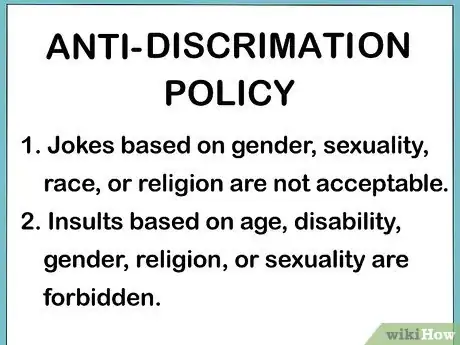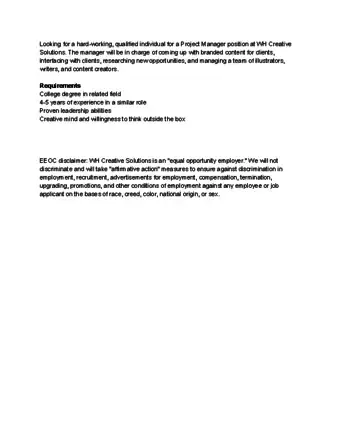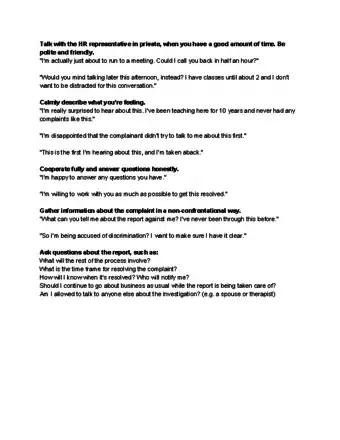This article was co-authored by James Fett. James Fett is a Lawyer based in Ann Arbor, Michigan. With over 35 years of experience, he specializes in alternative dispute resolution, civil litigation, civil rights, class actions, commercial litigation, employment litigation, and labor & employment. James earned a J.D. from The University of Michigan Law School as well as an MBA and BA from The University of Michigan. In 2001, he was awarded a Certificate of Special Congressional Recognition, and the Washtenaw Trial Lawyers Association named him Lawyer of the Year in 1996. He’s also been named a Michigan Super Lawyer by Law & Politics Magazine and one of the ten Most Outstanding Lawyers of the Year by Michigan Lawyers Weekly.
There are 19 references cited in this article, which can be found at the bottom of the page.
This article has been viewed 213,254 times.
Discrimination is defined as treating someone differently based on race, religion, gender, sexuality, age, or disability. It is important to foster an inclusive and welcoming atmosphere to avoid discrimination. In the workplace and school, put equal opportunity policies in place. If you rent or sell homes, take care that you do not accidentally include exclusive language or barriers while advertising your property. Even in daily interactions, you can reduce your bias by trying more open and accepting practices.
Steps
Avoiding Discrimination at Work
-
1Create an anti-discrimination policy for your workplace. Make sure your employees understand what types of behavior are and are not acceptable. Post these rules in public places like a lunch room, communal workspace, or water cooler. Send an email out to all of your employees as well.[1]
- Emphasize that jokes based on gender, sexuality, race, or religion are not acceptable to make in the workplace.
- Forbid derogatory language, such as racial slurs or insults based on age, disability, gender, religion, or sexuality.
- State that promotions, raises, and other opportunities will be decided on experience and skills, not on race, gender, sexuality, age, or religion.
-
2Enforce consequences for breaking the anti-discrimination policy. Write down the protocol for reporting incidents of harassment or discrimination in your workplace and post it near the rules. This will help employees understand what they must to do to report an incident as well as what the consequences are.[2]
- Consequences may include anti-discrimination training, a workshop with HR, or (depending on your industry) temporary leave.
- Make sure that employees understand that incidents of discrimination will be factored into their performance reviews.
Advertisement -
3Write job advertisements to appeal to a broad range of people. It is important that job postings do not discourage certain people from applying. Focus on what skills are necessary for the job. Avoid singling out a particular age, gender, or lifestyle for your ideal candidate.[3]
- Focus on skills, such as years of experience, technical capability, or degree requirements. Do not state that the ideal job is for young people, retirees, men, U.S. citizens, or other groups, as these can all be considered forms of discrimination.
- Insert a diversity and inclusion policy into your job advertisement. State that you are an equal opportunity workplace and do not discriminate based on gender, race, religion, ethnicity, or disability.
-
4Require the same documents from all applicants. Don’t ask for additional documents related to work history just because someone appears foreign or “ethnic.” As long as the employee can provide their I-9 and other required documents for the job, do not investigate their job history.[4]
-
5Handle accusations of discrimination seriously. If someone claims that they are being discriminated against, refer them to your human resources officer. Interview the people who are causing the discrimination, and write everything down. Keep these records in case another incident occurs.[5]
- Do not tell the person that they are being “too sensitive” or “imagining things.”
- Depending on the severity of the accusation, you may need to enforce disciplinary action, such as sensitivity training or job probation.
- If your business is too small for a dedicated HR position, appoint someone to be a “contact officer,” who is responsible for handling discrimination issues in addition to their normal duties.
-
6Provide yearly staff training on discrimination or harassment. Training might include sensitivity workshops, cross-cultural education, or an inclusivity seminar. Always remind your employees about the office’s anti-discrimination policies at these meetings.[6]
- Training should include topics of gender, race, LGBTQ+ status, size, disability, religion, and age.
-
7Make your office or workspace ADA accessible. Accessibility means that all of your employees can reach and access the necessary resources, locations, and tools necessary to complete their job. People with physical or mental disabilities may require different tools or resources.[7]
- Installing a ramp at a retail location, installing a sit/stand desk for an employee with a chronic back problem, or protecting an autistic person's ability to fidget at board meetings helps people with mobility issues, physical disabilities, or mental difficulties.
- If an employee asks to leave early for a doctor’s appointment or to work from home because of medical issues, it's best to give them the flexibility that they need. If the requests become extensive or constant, it may be time to chat with the employee about what's going on.
-
8Know the reasons why you can and cannot refuse service. You can't refuse service on the grounds of protected class, including (depends on your state): race, religion, sex, age, gender, disability, sexual orientation, nationality, ethnicity, familial status, veteran status, among others.
- For example, a formal restaurant can refuse service if the customer is not wearing formal attire.
- A formal restaurant, though, cannot refuse service solely because the customer is wearing a head covering for religious reasons.
Stopping Discrimination in Schools
-
1Use educational materials that represent a diverse group of people. Books, posters, videos, and other material used in classes should show people from different races, religions, and lifestyles. These materials will create a safe atmosphere and encourage children from different backgrounds to participate.[8]
-
2Call on students randomly to avoid favoring one group over another. To avoid seeming like you are favoring or picking on certain students, call on them randomly by picking names out of a bowl or writing their names on sticks. Don't call on them again until you have cycled through all of the names.[9]
-
3Provide accommodation for students with disabilities or other needs. If a student has a document called an Individualized Education Plan (IEP), you must provide reasonable accommodation for their situation.[10]
- Reasonable accommodation includes allowing them to use special devices in class, using a note taker, giving them extra time on tests, or giving the student more time to get between classes.
- Make sure that your school has ramps, elevators, and other structures to improve accessibility at the school.
- Even if the child does not have an IEP yet, work with them and their parents to create an accommodation plan that will help them succeed. This will help you avoid any claims of disability discrimination.
-
4Avoid asking students to be representatives of their race, religion, or lifestyle. While it may be welcoming to ask students to talk about their experience, singling them out can make them feel isolated or different. Let a student talk about these issues on their own. Try not to make them a token representative of their background.[11]
-
5Handle reports of bullying and discrimination quickly. Do not ignore the complaint or tell the student that they are being too sensitive. Investigate the issue by talking to students who may have witnessed the bullying. Take disciplinary action against the bullies if possible.[12]
- You might give the bullies detention or move them to a different class. You can also offer after-school counseling and sensitivity training to repeat offenders.
Reducing Housing Discrimination
-
1Consider all applicants for selling or renting a home. According to the Fair Housing Act in the U.S., you cannot discriminate when selling or renting a property due to a person's race, color, national origin, religion, sex, familial status and disability. When advertising a home, remember that you must treat all applicants equally.[13]
-
2Write an advertisement that focuses on the property, not on the tenant. The advertisement should contain the size, amenities, and cost of the home. Focus on the good qualities of the property. Don’t list what you want in a tenant, as this could be seen as excluding other types of people.[14]
- For example, don’t say that you would prefer young women to live in your home or that you don’t rent to students.
- Even words like “ideal for families” or “a perfect bachelor pad” can be seen as discrimination, as it might seem as though you are requesting a certain type of applicant.
-
3Set the same requirements for each applicant. Don't ask someone for a higher deposit, credit score, or references than you do other applicants. This can be seen as discrimination. Establish ahead of time what requirements a tenant must fulfill.[15]
- For example, don’t ask 1 person for more references just because they are young and single. Ask each potential tenant for the same number of references.
- If someone calls and asks about the home, make sure to give them the same exact information as you do everyone else. Don’t make assumptions about them based on their name or accent.
-
4Choose your tenants based on their income, credit, and references. Choosing a tenant should be based on business factors. If an applicant has the right income level to afford the home, good credit, and strong references, rent or sell them the home.[16]
-
5Avoid making exceptions for certain tenants. Don't do special favors or offer benefits to certain tenants and not others. If you give 1 tenant a month off of rent or lower their deposit, other tenants can argue that you prefer certain people.[17]
Speaking without Bias
-
1Use inclusive language instead of derogatory terms. Using accepting language is the first step to being inclusive and open. Pay attention to the terms that you use. Never use racial, sexual, or religious slurs.[18]
- Choose appropriate language when talking about disability, race, gender, age, etc. Most minority communities have specific language preferences which are very important to them.
- If you're not sure what language a specific person prefers, don't be afraid to ask them!
- When you're uncertain of someone's gender, stick to gender-neutral terms like “partner” instead of "boyfriend" or "girlfriend," “they” instead of “he” or “she,” and “parent” instead of “mom” or “dad.” Use your best judgment for when it is appropriate to use more gender-specific words.
- You may think a derogatory term is “okay” because a friend from a certain group might say it. Keep in mind, however, that this does not necessarily mean that it is acceptable for you to use that term.
- Choose appropriate language when talking about disability, race, gender, age, etc. Most minority communities have specific language preferences which are very important to them.
-
2Listen to others when they explain their ideas or experience. When someone else is talking, let them talk. Avoid interrupting them. Consider their ideas, validate their experiences, and make sure they know that you appreciate what they say.[19]
- It is common for certain groups of people to be silenced, ignored, or rejected because of their gender, race, religion, or identity. Even if you disagree with an idea, thank the person for giving it.
- Repeat back what people say so that they know you are listening. You can say, “What I am hearing is that you feel upset when your ideas are ignored.”
- In a group setting, make sure that everyone has a chance to be heard. If 1 person is monopolizing the conversation, say something like, “Thanks for your time. Now let’s hear from someone else.”
-
3Avoid assuming someone’s gender, sexuality, race, or nationality. Someone’s appearance, voice, or clothing is not a good indicator of their identity. When meeting people, do not make comments about their background unless they have specifically told you about you.[20]
- Don't ask someone what country they are from just because you think they look or sound like an immigrant.
- If someone asks you to use certain pronouns to refer to them, respect their wishes.
- If you're uncertain about something, ask politely. For example, you might ask, “Do you mind if I ask what terminology you prefer?"
-
4Tell appropriate, unoffensive jokes. Humor can lighten the mood, but it is often taken at another person’s expense. Avoid jokes that make fun of someone’s ethnicity, race, gender, or sexuality.
- Just because something is meant to be a joke doesn't mean that others won't find it offensive.
-
5Socialize with a wide variety of people. Hanging out with a more diverse group of people can help you reduce your own biases. Go out to meet people by trying new experiences. You can:[21]
- Volunteer at a charity.
- Join a social justice club.
- Take a class to learn a new skill.
- Visit a house of worship.
- Attend a cultural festival.
- Write to an international pen pal.
Anti-Discrimination Help for Employers and Teachers
Expert Q&A
-
QuestionHow can discriminatory practice be avoided?
 James FettJames Fett is a Lawyer based in Ann Arbor, Michigan. With over 35 years of experience, he specializes in alternative dispute resolution, civil litigation, civil rights, class actions, commercial litigation, employment litigation, and labor & employment. James earned a J.D. from The University of Michigan Law School as well as an MBA and BA from The University of Michigan. In 2001, he was awarded a Certificate of Special Congressional Recognition, and the Washtenaw Trial Lawyers Association named him Lawyer of the Year in 1996. He’s also been named a Michigan Super Lawyer by Law & Politics Magazine and one of the ten Most Outstanding Lawyers of the Year by Michigan Lawyers Weekly.
James FettJames Fett is a Lawyer based in Ann Arbor, Michigan. With over 35 years of experience, he specializes in alternative dispute resolution, civil litigation, civil rights, class actions, commercial litigation, employment litigation, and labor & employment. James earned a J.D. from The University of Michigan Law School as well as an MBA and BA from The University of Michigan. In 2001, he was awarded a Certificate of Special Congressional Recognition, and the Washtenaw Trial Lawyers Association named him Lawyer of the Year in 1996. He’s also been named a Michigan Super Lawyer by Law & Politics Magazine and one of the ten Most Outstanding Lawyers of the Year by Michigan Lawyers Weekly.
Lawyer Employers should have regular training on discrimination and harassment, and it should be documented. This is a great way to make sure everyone is on the same page and to avoid issues with discrimination and harassment. It's one of the factors that the court will consider in determining whether or not the employer will be responsible for any harassment.
Employers should have regular training on discrimination and harassment, and it should be documented. This is a great way to make sure everyone is on the same page and to avoid issues with discrimination and harassment. It's one of the factors that the court will consider in determining whether or not the employer will be responsible for any harassment. -
QuestionDoes discrimination have a positive side?
 Community AnswerNo.
Community AnswerNo. -
QuestionIs heightism still discrimination?
 Community AnswerShort and tall people are not generally considered a "protected class," and do not overall face major issues impacting their safety, ability to be hired, or risk of abuse and violence victimization. However, short men and tall women may be seen as less attractive, and sometimes are mocked or bullied by rude people. Sometimes, this is linked to ableist and anti-trans attitudes, which are especially serious. It is wrong for people to mistreat others based on their size, whether the person is a minority or not, even if it's "just a joke." Whether it counts as discrimination might be disputed, but it is definitely wrong and not acceptable. If you're a victim of or witness to bullying or other problems, talk to an authority figure for help. People of all body sizes deserve a peaceful environment free of harassment.
Community AnswerShort and tall people are not generally considered a "protected class," and do not overall face major issues impacting their safety, ability to be hired, or risk of abuse and violence victimization. However, short men and tall women may be seen as less attractive, and sometimes are mocked or bullied by rude people. Sometimes, this is linked to ableist and anti-trans attitudes, which are especially serious. It is wrong for people to mistreat others based on their size, whether the person is a minority or not, even if it's "just a joke." Whether it counts as discrimination might be disputed, but it is definitely wrong and not acceptable. If you're a victim of or witness to bullying or other problems, talk to an authority figure for help. People of all body sizes deserve a peaceful environment free of harassment.
Expert Interview

Thanks for reading our article! If you'd like to learn more about discrimination, check out our in-depth interview with James Fett.
References
- ↑ https://cdn.americanprogress.org/wp-content/uploads/issues/2012/03/pdf/lgbt_biz_discrimination.pdf
- ↑ https://cdn.americanprogress.org/wp-content/uploads/issues/2012/03/pdf/lgbt_biz_discrimination.pdf
- ↑ https://www.thehartford.com/business-playbook/in-depth/preventing-discrimination-job-employment-ads
- ↑ https://stg.justice.gov/sites/default/files/crt/legacy/2011/05/20/Rev10steps.pdf
- ↑ https://www.equalityhumanrights.com/en/multipage-guide/if-worker-complains-you
- ↑ https://www.shrm.org/hr-today/news/hr-magazine/pages/010215-cross-cultural-training.aspx
- ↑ http://employers.grb.uk.com/promoting-diversity
- ↑ http://www.understandingprejudice.org/teach/elemtips.htm
- ↑ http://articles.latimes.com/1998/apr/27/local/me-43565
- ↑ http://www.apa.org/pi/disability/dart/toolkit-three.aspx
- ↑ http://www.understandingprejudice.org/teach/elemtips.htm
- ↑ https://www.equalityhumanrights.com/en/multipage-guide/if-worker-complains-you
- ↑ http://www.apa.org/helpcenter/discrimination.aspx
- ↑ http://articles.latimes.com/1995-02-12/realestate/re-31144_1_fair-housing
- ↑ https://www.nolo.com/legal-encyclopedia/choosing-tenants-avoid-fair-housing-29816.html
- ↑ https://www.nolo.com/legal-encyclopedia/choosing-tenants-avoid-fair-housing-29816.html
- ↑ https://www.nolo.com/legal-encyclopedia/choosing-tenants-avoid-fair-housing-29816.html
- ↑ https://www.linguisticsociety.org/resource/guidelines-inclusive-language
- ↑ https://www.forbes.com/sites/forbescoachescouncil/2016/06/07/11-ways-male-leaders-can-adjust-communication-in-order-to-be-more-inclusive-to-women/#6e25467a4638
- ↑ https://www.glaad.org/transgender/allies
- ↑ http://open.lib.umn.edu/socialpsychology/chapter/12-3-reducing-discrimination/
About This Article
It’s important to avoid discrimination and instead encourage inclusivity by speaking out against bias. In your everyday life, use inclusive language instead of derogatory terms. For example, if you’re uncertain of a person’s gender, use neutral terms, like “partner” instead of “boyfriend” or “girlfriend.” It’s also important to listen to others when they explain their ideas or experiences, whether you agree with or understand them or not. If you’re in a group setting, make sure that no one person or group dominates the conversation. Instead, try to emphasize a variety of voices and opinions and make sure that no one person or group feels silenced. To learn how to avoid discrimination in the workplace, keep reading!
























-Step-24.webp)

















-Step-24.webp)





































